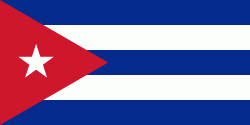Santa Clara (Municipio de Santa Clara)
 |
 |
Santa Clara was founded by 175 people on July 15, 1689. 138 of them represented two large families already living in the area, who owned land next to the new city. The other 37 came from seven other families and included a priest and governor, all originating in the coastal city of San Juan de los Remedios.
The population of Remedios had to choose between leaving their city, constantly being besieged by pirates, or staying. While most decided to stay, 37 people traveled south to the interior. On June 1, 1689, they arrived at a hill, joining two other families already present at the site. According to tradition, a mass was celebrated under a tamarind tree and Santa Clara was founded. Since then, the place under the tree has been known as Loma del Carmen. A second-generation church was built in a park along the plaza. A monument commemorating the event is surrounded by a fourth-generation tamarind tree.
The settlement was originally called Cayo Nuevo, which was changed to Dos Cayos, Villa Nueva de Santa Clara, Pueblo Nuevo de Antón Díaz, Villa Clara, and finally Santa Clara.
Construction of the city began near Loma del Carmen. Following the Spanish standards, a perfect squared layout with a central plaza (Plaza Mayor, today known as Parque Vidal) was developed. The first buildings erected were the cabildo (city council) and a palm tree church. The latter building was replaced in 1725 with a brick one. It remained at the center of the Parque Vidal as Catedral de Santa Clara de Asís until August 22, 1923. It was demolished so that the plaza could be expanded and a new church built nearby. This decision by the mayor is still criticized to this day. Although the church was not of the finest architecture, it was one of the oldest colonial structures in the city and a part of its fabric. After the expropriation by the mayor and city council, religious officials complained and the court awarded 77,850 pesos in fines as a settlement to the church.
Soon after the city was founded, a theater, a chamber of commerce, meeting clubs, public libraries, and dance halls were erected as well. Positioned nearly in the center of the country, the city became a popular travelers' stop and a prominent transport hub; these conditions supported its steady growth. By the 19th century, Santa Clara was bigger and more populated than nearby towns, including what was once Remedios. As a necessary stop between Havana and the east of the country, the city became the capital of Las Villas province.
Map - Santa Clara (Municipio de Santa Clara)
Map
Country - Cuba
 |
 |
| Flag of Cuba | |
The territory that is now Cuba was inhabited by the Ciboney people from the 4th millennium BC with the Guanahatabey and Taíno peoples until Spanish colonization in the 15th century. From the 15th century, it was a colony of Spain, and slavery was abolished in 1886, remaining a Spanish colony until the Spanish–American War of 1898, when Cuba was occupied by the United States and gained independence in 1902. In 1940, Cuba implemented a new constitution, but mounting political unrest culminated in a coup in 1952 and the subsequent dictatorship of Fulgencio Batista, which was later overthrown in January 1959 by the 26th of July Movement during the Cuban Revolution, which afterwards established communist rule under the leadership of Fidel Castro. The country was a point of contention during the Cold War between the Soviet Union and the United States, and a nuclear war nearly broke out during the Cuban Missile Crisis of 1962. Following the collapse of the Soviet Union, Cuba faced a severe economic downturn in the 1990s, known as the Special Period. In 2008, Fidel Castro resigned after 49 years of leadership of Cuba and was replaced by his brother Raúl Castro.
Currency / Language
| ISO | Currency | Symbol | Significant figures |
|---|---|---|---|
| CUC | Cuban convertible peso | $ | 2 |
| CUP | Cuban peso | $ | 2 |
| ISO | Language |
|---|---|
| ES | Spanish language |















